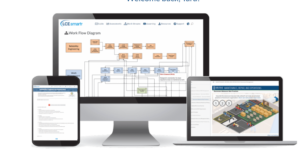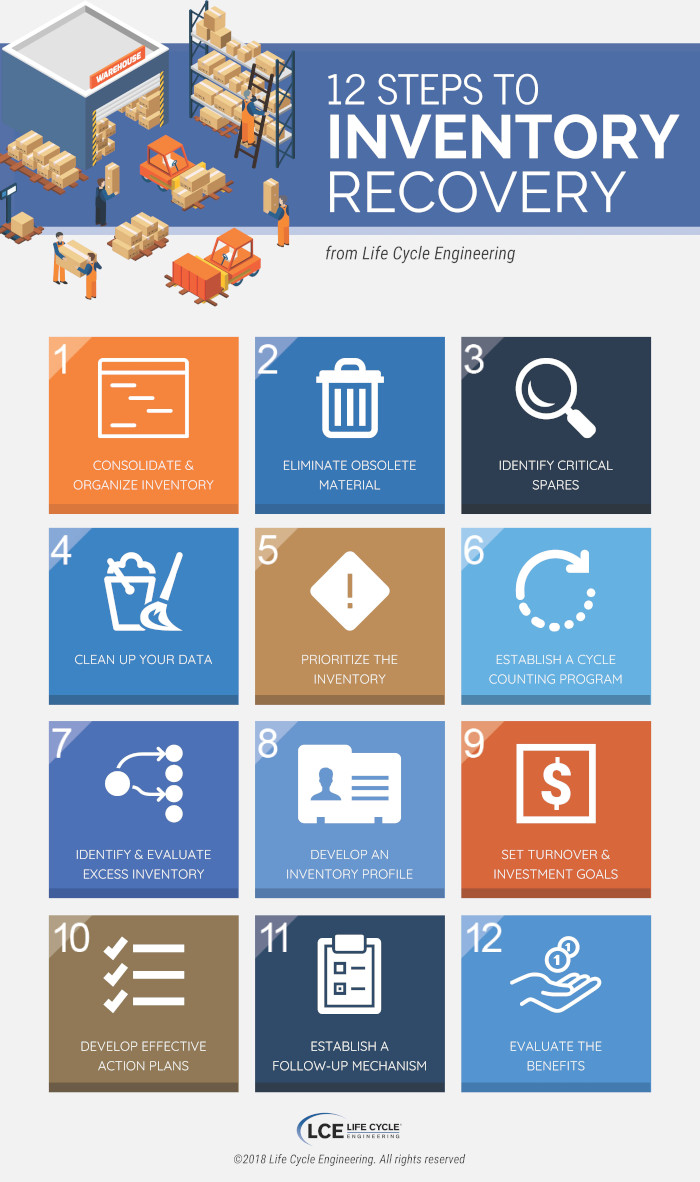The original 12-Step Recovery Program was developed in the 1930s and incorporated by Alcoholics Anonymous to help people deal with their “powerlessness” to stop drinking. Since then the 12-step model has been adopted by many other groups dealing with an array of issues that all have one thing in common: a desire to stop.
Google “12-Step Model” and you’ll find all kinds of variations on the theme that deals with social problems, scientific techniques, religious issues, and medical maladies – even one on how to partition 1/2” tape in a cartridge tape unit! Nowadays it seems like almost anything can be solved in 12 easy steps.
What about bloated inventories? What about warehouses overstocked with inactive and unusable parts? What about an investment that is literally “going through the roof?” These are all indications of poor inventory management, yet there are still some people out there who, despite these symptoms, continue to cram more and more material into every available nook and cranny. Even though they know it’s wrong, internal and external forces make them feel powerless to do anything about it. What can be done for Materials Managers with a desire to stop this dangerous behavior?
Don’t worry, there’s a 12-step program for that, too! But before we get into the details of how to go about it, let’s explore a few of the underlying principles that have intriguing applications in the material world (pun intended).
Own up
One of the most widely-recognized characteristics of 12-step groups is the requirement that members admit they have a problem. Everyone is familiar with the catchphrase, “Hi, my name is X, and I am Y.” Of course, the assumption is that the immediate response from the rest of the group will be unflinching support accompanied by empathetic acclamation and enthusiastic applause. This may be an unrealistic scenario in a manufacturing environment.
It might not be a good career move to stroll into the boss’s office for your performance review and confess all of your shortcomings. Your employees may look askance if they witness you in your office offering up a litany of deficiencies to anyone within earshot. But coming to the realization that your inventory is too high is a critical first step. Verbalizing it can even be cathartic.
Recognize the situation for what it is
The 12-step program typically addresses addictions, individuals have uncontrollable cravings coupled with a psychological obsession that rationalizes continuing an often destructive behavior. On a personal level, compulsive shopping and hoarding might be considered an addiction. In a materials environment, it is more likely that overspending and excessive stock levels are simply indications of improper training, lack of discipline, poor fiduciary controls, or just a bad habit.
Nonetheless, the resulting inventory is a crutch that can get in the way of the overall health of the operation and keep it from running at peak performance levels. As a practical aid, a crutch should only be used while medical treatment and physical therapy complement the natural healing process. If relied on for too long, the use of artificial support mechanisms can result in atrophy or total loss of functionality altogether.
Likewise, a little bit of inventory can be a good safeguard against short-term material demand or supply fluctuations, or even as a temporary hedge while effective inventory management work processes are put in place. However, if inventory itself is the only means of assuring adequate material service levels, the financial burden of the associated investment will at best be a drain on valuable resources, and at worst can cripple an organization beyond repair.
Change or else
People who successfully complete a rehabilitation program will often refer to it as a life-saving experience: “If I hadn’t done this, I wouldn’t be alive now.” The May 2005 issue of Fast Company magazine featured a cover story entitled “Change or Die” by Alan Deutschman. The referenced research concluded, among other things, that people who do not work actively at mental rejuvenation face a 50% chance of senility by the age of 85. The article also asserts that coronary bypass patients must drastically alter the lifestyle that caused their heart disease or it will ultimately kill them (hence the title). These are grim realities, but they reinforce the need to “change or be changed.”
While the personal stakes may not be quite as dire in a manufacturing environment, there are many Materials people operating under a management philosophy of “change or lose your job,” and even more who are “pursuing new career paths” because of the inability or unwillingness to do things differently.
Seek help
Participants in 12-step programs meet regularly to share their experiences and gain strength from their peers. Recovery starts by taking individual responsibility for one’s own plight but often depends on a strong external support system to assure continued progress and avoid relapses.
Your inventory problem wasn’t created overnight, and most likely you are not solely responsible for causing it. Correcting the situation can take a long time as well, and will require the involvement of almost every organization in the plant, including maintenance (craftsmen and planners), production, finance, purchasing, engineering, and plant management.
The 12 Steps
With the guiding principles in place, you can apply the 12 steps below in a logical sequence to travel the road to inventory recovery.
- Consolidate and Organize Your Inventory
Eliminate those pockets of unauthorized material you have stashed all over the place. Clean out the desk drawers and cabinet tops. Dig into those corners and cubby holes. Climb up into those mezzanines. Get a complete and accurate accounting of exactly what you have, where it is, and how many there are. Until you get a handle on this, everything else is a waste of time, and time is money.
- Eliminate Obsolete Material
MRO is supposed to stand for “Maintenance, Repair and Operations,” not Mostly Really Old. In that trove, you’ll find items that have died on the vine due to damage, corrosion, shelf-life, lack of maintenance, or other factors that make them totally useless. There will be others that are in good shape but can’t be used because the part has been replaced or redesigned, or else the equipment it’s used on has been modified or decommissioned.
Resist the temptation to hold onto this stuff “just in case.” Keeping it around wastes valuable space, and may also consume inordinate amounts of time, money, and other resources required to store and handle it. Identify and physically segregate all unusable material. Determine disposition (dump it, recycle it, scrap it, sell it, donate it), and get rid of it as soon as possible. If it’s on the books, you may have to lessen the impact on bottom-line plant results by establishing a monthly scrap budget and spreading the expense over a period of time. If it’s not on the books, it should move right away.
Sure, you may end up tossing one or two items that you wish you had back, but for every one of these, there will be 10 or even 100 times as many that you’ll never be sorry about. You might end up spending a little money you didn’t have to, but as long as you get rid of the right things for the right reasons, you’ll save a lot more in the long run.
- Identify Critical Spares
Once you know you have “the right stuff” on hand, identify the items that you just can’t afford to be without. Often these will be direct replacements or repair parts for equipment that can result in a significant loss of production if it’s down for even a short period of time. Typically they are high-cost, low-volume, and/or long-lead-time items, and they don’t necessarily have to be on hand, but they do need to be readily available, usually with much less than 24 hours notice.
- Clean Up Your Data
Whether you are working with a sophisticated CMMS, using spreadsheets, or keeping track of your inventory on the back of napkins, reliable information is crucial. Without well-organized, highly-accurate data, it is almost impossible to properly manage your inventory.
This includes basic part data, such as standardized classifications and descriptions, item numbers, and unit costs. It includes ordering information, such as replenishment type, min/max levels, and lead times. It includes BOM and where-used data to ensure that parent/child relationships between parts and equipment are accurate. It includes storeroom information, such as bin locations, on-hand quantities, and stocking denominations. It includes transaction history data, such as quantity and date of last receipt, issue, and cycle count. It also includes any parametric data, such as ABC class, critical spare, obsolete material, consignment, or other part-specific flags.
Data that is not proactively managed will naturally degrade over time. Periodically review data to ensure that the most accurate information is being used to make critical inventory management decisions
- Prioritize the Inventory
Perform an ABC analysis or other formal prioritization process annually to ensure that the most attention is given to the items that have the greatest impact on service and investment. Inventory management pretty closely follows the 80/20 rule, and as they say, “Don’t sweat the small stuff!” There are a lot more important things you can do than chase around off-the-shelf nickel and dime items.
- Establish a Robust Cycle Counting Program
Cycle counting is not a 100% physical inventory. It’s not something designed to satisfy the auditors at the end of the fiscal year. Nor is it just a clever way to keep your storekeepers busy during slow times. Cycle counting is a way to ensure that you have the parts you think you have. A robust program also helps you assess the health of your work processes, determine the root cause for errors, and implement corrective actions as necessary.
Cycle counting should be done more often than necessary at first, especially in an environment without disciplined work processes in place. As practices improve, cycle count results will also improve, and you can modify frequencies so that fewer and fewer counts are required. The ultimate goal is to have such reliability in the work processes and such high levels of balance accuracy that an annual physical inventory may not even be required to close the books.
- Identify and Evaluate Excess Inventory
Excess inventory is to usable material and obsolete inventory is to unusable material. For a variety of reasons – some legitimate – you might find yourself overstocked with good-quality parts. Contrary to popular belief, it is possible to have too much of a good thing! Depending on the nature of the item and the anticipated demand, these excess inventories may be worked off through normal usage. In other cases, however, they may need to be managed by more proactive methods, such as returning the parts, reselling them, or even giving them away.
- Develop an Inventory Profile
Evaluate the amount of investment you have tied up in critical spares, obsolete material and excess inventory. Understand how your usable items are distributed by ABC classification. Don’t forget to factor in the potential impact of consignment or vendor-stocked material that is not on your books, but could represent a future investment liability. An inventory profile that summarizes all of this information at a total plant level provides a quick and effective assessment of the overall “health” of your storeroom inventory.
- Set Realistic Turnover and Investment Goals
Turnover – the ratio of usage dollars to investment – is the best measuring stick for determining the effectiveness of your inventory management. As with the stock market, past history is no guarantee of future results. However, in lieu of other major factors, such as a capital project or the commissioning of new equipment, it is reasonable to assume that aggregate usage levels will remain relatively stable in the near term, which means that turnover will be primarily impacted by investment.
In simplest terms, investment is a function of storeroom input (material purchases) and output (material usage). As a Materials Manager, you are responsible for issuing required parts, but you have little influence over what those requirements will actually be. However, either directly by yourself, and/or indirectly through Purchasing, you have a significant impact on which parts will be bought and put into inventory.
For a particular organization, there is no optimum investment target per se. Your required inventory levels will depend on a number of variables that differ from industry to industry, company to company, and even plant to plant. However, there are set goals for a turnover that provide competitive benchmarks for comparing your inventory management practices to established standards.
Before locking in a turnover goal, recognize the fact that it is not the turnover ratio you are managing for directors. Instead, you are managing the investment, which is the major contributing factor. Rather than setting arbitrary or unachievable goals for turnover, make sure the goal translates to a realistic inventory target.
- Develop Effective Action Plans
Improvements in turnover are rarely achieved through serendipity. Simply setting a target does not make it a self-fulfilling prophecy. Achieving aggressive goals requires identifying the key activities necessary to make it happen. How much of your obsolete inventory will you be scrapping? How much can you reduce your overstock? What items can be set up on consignment? How can the most active items be managed to get the biggest impact on investment?
If you don’t have a plan, then everything is up to chance. You might know your destination, but if you don’t have any idea how to get there, the trip will be that much more difficult. Answering these and other important questions will help you avoid surprises and develop an action plan that will point you in the direction you need to go.
- Establish a Follow-Up Mechanism
Having a plan won’t necessarily get the desired results, but at least it will give you a tool to help explain your performance. Did everything happen as planned? Were there any unforeseen events? The key is to regularly review what actually occurred vs. what you thought was going to occur. A monthly or even quarterly review of action plans and results will help to review progress, maintain momentum, and determine the necessary course corrections to continue toward your goals.
- Evaluate the Benefits
Is all this hard work worth the effort? Improving turnover isn’t just a make-work exercise in inventory management. For one thing, the gap between your turnover ratio and best-in-class benchmarks will give you an indication of how much room there still is for improvement, and therefore how much additional effort is needed.
More importantly, there are other costs associated with investment besides just the purchase price. The cost of carrying inventory can range anywhere from 15 – 20% per year or more depending on the cost of capital, insurance, taxes, embedded storage and handling costs, and other factors. This is not “funny money.” These are real dollars that change hands through actual financial transactions.
A common misconception is that once an item has been purchased and put into stock, it’s fully paid for, so there are no incremental costs associated with keeping it. The reality is that carrying costs accrue every day an item sits in the storeroom. Depending on the annual carrying cost percentage, you might indirectly pay for that same item, again and again, every few years.
The better approach is to view inventory reduction as an opportunity for significant tangible savings. Again depending on the carrying costs, each dollar of inventory reduced equates to a savings of 15 to 20 cents or more each year that can be reinvested in the business or go right to the bottom line.
Conclusion
In much the same way as the original 12-Step Model helps individuals regain control of the physical, mental, emotional, spiritual, and psychological aspects of their personal lives, this 12-step model can help Materials Managers regain control of the financial resources that are a critical part of their vocational lives.
Doug Wallace is a Senior Materials Management Subject Matter Expert for Life Cycle Engineering with over 30 years of combined experience as a manager and management consultant. You can reach Doug at dawallace@LCE.com.

















